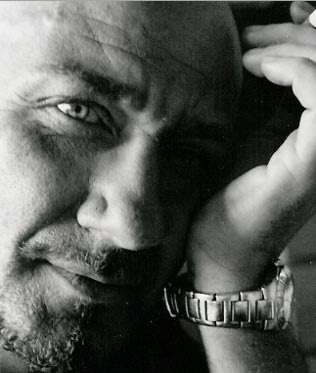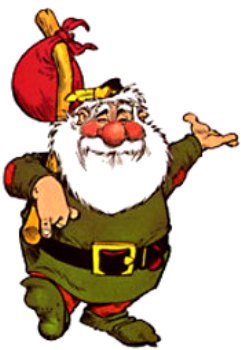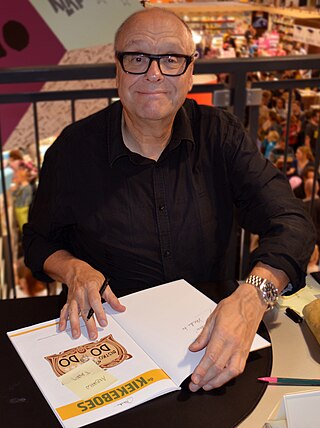Eric de Noorman ("Eric the Norseman") was a Dutch comic strip, published in text comic format, and drawn by Hans G. Kresse from 1946 until 1964. The stories featured a Viking king, Eric, and his adventures overseas. Together with Kapitein Rob and Tom Poes , Eric de Noorman is widely considered to belong to the Big Three in Dutch comics history. [1] Kresse's well documented stories and high quality drawing are praised and have influenced many other European comics artists. Eric de Noorman is one of the few Dutch comics to gain popularity in foreign translations. In the Netherlands, it was published in Het Vaderland, De Nieuwe Haarlemsche Courant and Tom Poes Weekblad, in Flanders in Het Laatste Nieuws and De Nieuwe Gazet, in Wallonia in Le Soir . [2] The comic has been translated into French, Danish, Finnish, German, Spanish, Swedish, Portuguese and English. [3] From 1948 on the stories were published in oblong format books at the low price of 75 cent.
Concept
Eric de Noorman is set during a vague Viking Age. Eric is a young Norse Viking king who lives together with his wife, Winonah, and son Erwin. Pum-Pum, a midget servant, is his trusty aid and advisor. He often travels abroad which brings him into all kinds of fights and adventures. In the earliest stories Eric is both seen in the Roman Empire as well as the Dark Ages of the Middle Ages. In one story he fights against Roman Emperor Commodus (177-192) in the arena. Afterwards he returns to Norway, where he is in the presence of noblemen living in castles in fashions that are more reminiscent of the 12th and 13th centuries. Apart from these anachronisms, Kresse also used a lot of fantasy elements, such as Norse mythology and the Isle of Atlantis. From the story De Witte Raaf ("The White Raven") on, Kresse used more documentation which made the stories more historically accurate. He set the stories in a specific time period, namely the 5th century. This allowed Eric to meet historical and mythological characters such as the British king Vortigern (Vitalinus), King Arthur, Attila the Hun and Flavius Aetius. Apart from historical accuracy Kresse also drew real-life locations such as Hadrian's Wall, Stonehenge, the menhir field of Carnac and the Mousa Broch. The more magical elements disappeared from the series. [4]
Originally Kresse followed scripts by Dirk Huizinga and Waling Dijkstra, but he eventually went his own way. [5]
Publication history
In total about 67 Eric stories were published between 1946 and 1964. All of them were drawn in the text comic format, which was the dominant comic strip genre in the Netherlands until deep into the 1950s. Some stories of Eric have been published with text balloons for publication too. Since the 1970s publishing company Panda has republished all stories chronologically and integrally. Historian Rob van Eijck, a fan of the series, wrote the introductions to these volumes.
From 1966 to 1974 Kresse drew a spin-off series, Erwin de Noorman, about Eric's son Erwin. These stories were published with text balloons. [7]
In popular culture
Eric de Noorman was first published in the Flemish newspaper Het Laatste Nieuws . Their youth magazine Pum-Pum (1951-1967) was named after the eponymous midget character in the series. [10]
Willy Vandersteen was a fan of the series and used it as an inspiration to his own realistically drawn adventure stories, such as De Rode Ridder . Dutch comics artist Dick Matena also sees Kresse as a personal hero and published a homage to Eric de Noorman, titled Mijmeringen bij een mythe. [11] He also once drew a parody of the series for Playboy [12]
In 2006, to celebrate the 60th anniversary of the comic, twenty large drawings were attached to the walls of several buildings in Arnhem [13]

Philippe Vandevelde, working under the pseudonym Tome, was a Belgian comics writer. He was known for collaborations with Janry on Spirou et Fantasio and Le Petit Spirou, and with Luc Warnant and later Bruno Gazzotti on Soda. He also collaborated with Ralph Meyer on Berceuse assassine, and with Marc Hardy on Feux. Earlier in his career he was an assistant-artist for Dupa.
Thor, the god of Norse mythology, has appeared as a character in various comics over the years, appearing in series from a range of publishers.
Notable events of 1964 in comics.

Storm is a soft science fiction/fantasy comic book series originally drawn by Don Lawrence. It tells the adventures of an astronaut who accidentally gets lost in time. The series originated in Dutch, but has since been translated into many other languages.

Tom Puss is a Dutch comic strip, created by Marten Toonder. Together with Hans G. Kresse's Eric de Noorman and Pieter Kuhn's Kapitein Rob it is regarded as the Big Three of Dutch comics.
Notable events of 1937 in comics.

Douwe Dabbert is a Dutch fantasy comics series by artist Piet Wijn and scenarist Thom Roep. It was published in the Netherlands between 1975 and 2001, and in the United States beginning in 2021.
The Stripschapprijs is a Dutch prize awarded to comic creators for their entire body of work. It is awarded annually by the Stripschap, the Dutch Society of comics fans, since 1974. The prize is non-pecuniary, but is considered the most important award for comics in the country.
Dutch comics are comics made in the Netherlands. In Dutch the most common designation for the whole art form is "strip", whereas the word "comic" is used for the (usually) soft cover American style comic book format and its derivatives, typically containing translated US superhero material. This use in colloquial Dutch of the adopted English word for that format can cause confusion in English language texts.

Merho, is a Belgian comic-book writer and artist, best known for creating the comic strip De Kiekeboes.
Notable events of 1992 in comics.
Notable events of 1946 in comics.
Notable events of 1953 in comics.
Notable events of 1967 in comics.

Dick Matena is a Dutch comics writer and cartoonist. He has also published under the pseudonyms A. den Dooier, John Kelly and Dick Richards. He has made several kinds of comics, from humor comics to erotic comics, but is best known for his comic book adaptations of famous literary novels.
Hans G. Kresse was a Dutch cartoonist. He was the winner of the 1976 Stripschapprijs.
Kapitein Rob was a Dutch adventure comic strip, created and drawn by Pieter Kuhn and written by journalist Evert Werkman. The series ran from December 11, 1945 until January 21, 1966. Together with Marten Toonder's Tom Poes and Hans G. Kresse's Eric de Noorman it is considered to be among the Big Three in the history of Dutch comics.

Text comics or a text comic is a form of comics where the stories are told in captions below the images and without the use of speech balloons. It is the oldest form of comics and was especially dominant in European comics from the 19th century until the 1950s, after which it gradually lost popularity in favor of comics with speech balloons.
Celebrity comics are comics based on the fame and popularity of a celebrity. They are a byproduct of merchandising around a certain media star or franchise and have existed since the mass media and comics came into existence in the 19th century. Celebrity comics are usually not held in high esteem by critics, because of their purely commercial nature. They are solely created to capitalize on media trends and therefore published so quickly and cheaply that drawings and narratives tend to be of very low quality.
Notable events of 2022 in comics. It includes any relevant comics-related events, deaths of notable comics-related people, conventions and first issues by title.
This page is based on this
Wikipedia article Text is available under the
CC BY-SA 4.0 license; additional terms may apply.
Images, videos and audio are available under their respective licenses.






